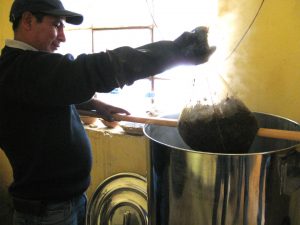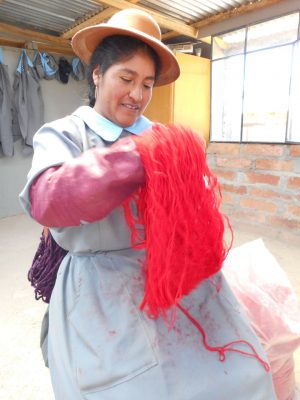HAND SPINNING ON ELECTRIC SPINNER
COOPECAN’S WORKSHOP
Our supplier, the Coopecan cooperative, operates a workshop where alpaca fiber is hand spun.
Baby alpaca fiber is mechanically carded and combed before being spun by the expert hands of a group of women from the Sicuani region. Spinning is done by hand on an electric spinning wheel. This device resembles a sewing machine, including foot control.


These ladies need to focus on the task in order to reach the best uniformity possible.
The simple thread obtained must then be twisted (folded) to yield a 2-ply yarn of the desired size. This step is also done manually.
THE DROP SPINDLE
Spinning can be done using a number of methods. For example, the knitters of Arte-Aymara Association also spin alpaca fiber but they use a drop spindle. This basic tool is best suited to their daily lives. Indeed, throughout the day, artisans move a lot to graze their animals and to attend to various agricultural and family duties. The drop spindle is very small and can be carried in a handbag. It is therefore much more practical than a spinning wheel! The drop spindle also represents the typical spinning tool that every Peruvian alpaca breeder has. We have incorporated this symbolic tool into PachaMama Canada’s logo to recognize a tradition that needs to be protected. See this page for more information on the technique used by Arte-Aymara knitters.
NATURAL DYES
 Coopecan’s workshop is also the place where natural dyes derived from plants and insects (cochineal – see explanation below) are made. The recovery of ancient knowledge has allowed the team to standardize traditional recipes to offer us many original colours. The master dyer, Mr. Huarcaya, dyes alpaca yarn ranging from fireman red to yellow via a rich palette of colours.
Coopecan’s workshop is also the place where natural dyes derived from plants and insects (cochineal – see explanation below) are made. The recovery of ancient knowledge has allowed the team to standardize traditional recipes to offer us many original colours. The master dyer, Mr. Huarcaya, dyes alpaca yarn ranging from fireman red to yellow via a rich palette of colours.
The skeins are soaked in steeped mixtures of plants and/or cochineal to soak up the colour pigments. A mordanting solution of natural alum and cream of tartar is applied beforehand to the steeped mixtures to properly set the dyes in the fiber.
Cochineal (Dactylopius coccus)
 The Cochineal, a scale insect found in large numbers on Andean cacti and also cultivated, is used for its rich range of red, pink and violet tones.
The Cochineal, a scale insect found in large numbers on Andean cacti and also cultivated, is used for its rich range of red, pink and violet tones.
The Aztecs of Mexico were the first to cultivate Dactylopius coccus for its rich reds and purples. This cactus parasite was soon coveted by Spanish settlers who caused it to become the material of choice in international trade. Indeed, during the spice trade dyes were also highly sought after, especially red “carmine “. This colour is also part of Canada’s history because it was used in the manufacture of the RCMP uniform.
The red dye from the cochineal is named after the carminic acid found in the body and eggs of the insect. This carminic acid acts as a natural pesticide to protect the cochineal from predators. In addition to the textile field, cochineal is also used as food colouring, even today.
Dactylopius coccus is found in abundance on Opuntia cactus varieties, and grown mainly in Latin America. Peru is the largest producer of cochineal but cochineal breeding is practiced in many places around the world.
Sources: sciencepresse.qc.ca, lesfilsdutemps.free.fr/tincto.htm, marchand.d.idees.free.fr
* * *
Washing Instructions
Hand wash in cold water (30 degrees), with a mild soap or shampoo. Wrap in a towel (do not wring). Dry flat. Apply these guidelines to all alpaca fiber knitted and woven products.
Important note about naturally dyed yarns:
It is normal that the wash water is colored when you wash a natural dyed product, particularly in the first wash. It is the same for many manufactured products like jeans. It is the excess dye coming out of the fiber. This is called disgorgement.
Dyes used by Coopecan are fixed with effective mordants. Many washes are also performed on-site but the disgorgement is difficult to avoid, especially with the presence of many strong products in our waters and in some detergents. The colours obtained with natural dyes are resistant to washing and the process of time but it is normal that they gradually lose their brightness.
It is therefore important to wash these products in cold water with a mild soap to maximally preserve the dyes. As a precaution, we recommend washing the colors separately and/or wash the skeins before knitting a combination of very distinct colors. Soaking with vinegar is also an effective trick to prevent disgorgement: soak product in a mixture of one part white vinegar in five parts water for 30 minutes, rinse thoroughly.







